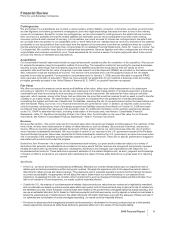Pfizer 2009 Annual Report Download - page 21
Download and view the complete annual report
Please find page 21 of the 2009 Pfizer annual report below. You can navigate through the pages in the report by either clicking on the pages listed below, or by using the keyword search tool below to find specific information within the annual report.
Financial Review
Pfizer Inc. and Subsidiary Companies
•a decrease in revenues from certain legacy Pfizer products, including Lipitor, Norvasc, Campostar and Chantix/Champix.
Geographically,
•in the U.S., Biopharmaceutical revenues increased 6% in 2009, primarily due to revenues from legacy Wyeth products of approximately
$1.6 billion, or 9%, which were partially offset by lower revenues from certain legacy Pfizer products, including Lipitor and Celebrex,
compared to 2008, as a result of continued generic pressures. Legacy Pfizer revenues also were adversely affected by the loss of
exclusivity of Camptosar and Zyrtec/Zyrtec D, lower sales of Chantix following the changes to the product label, increased rebates
partly as a result of the impact of certain contract changes, and increased pricing pressures. These factors were partially offset by the
solid performance from certain legacy Pfizer products, including Lyrica, Viagra, Revatio, Xalatan and Sutent, and alliance revenues in
2009; and
•in our international markets, Biopharmaceutical revenues were flat in 2009, compared to 2008. Higher revenues due to the addition of
legacy Wyeth products of $931 million, or 4%, and higher operational revenues from legacy Pfizer products of $783 million, or 3%, were
offset by the unfavorable impact of foreign exchange on international revenues of $1.7 billion, or 7%. The increase in operational
revenues of legacy Pfizer products was due to operational growth from Lipitor, Lyrica, Zyvox, Vfend, Sutent and alliance products,
partially offset by lower revenues of Norvasc and Camptosar, among others.
During 2009, international Biopharmaceutical revenues represented 56% of total Biopharmaceutical revenues, compared to 57% in
2008.
Effective January 1, 2010, August 14, 2009, and January 3, 2009, we increased the published prices for certain U.S.
Biopharmaceutical products. These price increases had no material effect on wholesaler inventory levels in comparison to the prior
year.
2008 vs. 2007
Worldwide Biopharmaceutical revenues in 2008 were $44.2 billion, a decrease of 1% compared to 2007, primarily due to:
•a decrease in revenues for Zyrtec/Zyrtec D of $1.4 billion in 2008, primarily due to the loss of U.S. exclusivity and the cessation of
selling this product in late January 2008 as a result of the 2006 divestiture of our former consumer healthcare business;
•a decrease in revenues for Norvasc of $757 million in 2008, primarily due to the loss of U.S. exclusivity in March 2007;
•an increase in rebates in 2008 due to a 2007 favorable adjustment recorded in 2007 based on the actual claims experienced under the
Medicare Act, as well as the impact of our contracting strategies with both government and non-government entities in the U.S.;
•a decrease in revenues for Camptosar in the U.S. of $457 million in 2008, primarily due to the loss of U.S. exclusivity in February 2008;
•a decrease in revenues for Lipitor in the U.S. of $863 million in 2008, primarily resulting from competitive pressures from generics,
among other factors; and
•an adjustment to the prior years’ liabilities for product returns of $217 million recorded in 2008,
partially offset by:
•an aggregate increase in revenues from products launched in the U.S. since 2006, particularly Sutent, and from many in-line products,
including Lyrica, which increased 41% in 2008; and
•the weakening of the U.S. dollar relative to many foreign currencies, especially the euro, Japanese yen and Canadian dollar, which
increased Biopharmaceutical revenues by approximately $1.5 billion, or 3.3%, in 2008.
Geographically,
•in the U.S., Biopharmaceutical revenues in 2008 decreased 13% compared to 2007, primarily due to the effect of the loss of exclusivity
on Norvasc, Zyrtec/Zyrtec D and Camptosar, an adjustment to the prior years’ liabilities for product returns (approximately $160 million)
recorded in the third quarter of 2008, higher rebates, lower sales of Lipitor and lower sales of Chantix following the changes to its U.S.
label in 2008, partially offset by the increase in revenues from products launched since 2006, except for Chantix, and from many in-line
products; and
•in our international markets, Biopharmaceutical revenues in 2008 increased 11% compared to 2007, primarily due to the favorable
impact of foreign exchange on international revenues of approximately $1.5 billion, or 6.5%, in 2008, revenues from some of our
products launched since 2006, as well as growth of certain in-line products, partially offset by an adjustment to the prior years’ liabilities
for product returns (approximately $60 million) recorded in the third quarter of 2008.
Diversified Revenues
2009 vs. 2008
Worldwide Diversified revenues in 2009 were $4.2 billion, an increase of 17% compared to 2008 due to:
•revenues from legacy Wyeth products of approximately $764 million, primarily from the addition of the legacy Wyeth Consumer
Healthcare and Nutrition operations,
2009 Financial Report 19
























